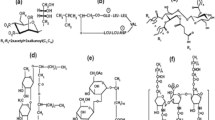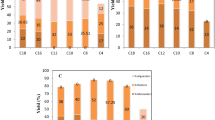Abstract
Biosurfactants are a group of surface active agents which are produced by a variety of microorganisms. These materials are safer than their synthetic counterparts regarding the environmental concerns. In this research the application of rhamnolipid (a biosurfactant produced by Pseudomonas aeruginosa) in the formulation of a washing powder was investigated. The biosurfactant was mixed with sodium tripolyphosphate as a builder and sodium sulfate as filler, and was applied to washing pieces of cotton clothes which were contaminated with known amounts of edible oil. The effects of pH and temperature of washing medium, washing time, the stirrer velocity of the washing system, and the weight percentage of rhamnolipid and builder on the washing efficiency of the formulation were examined. The results showed that the biosurfactant was effective in oil removal from the samples. The results moreover showed that the optimum pH was 7, and for the other parameters higher levels gave better results. The formulation presented in this study was also compared with some commercial powders for the removal of edible oil, chocolate, and albumen stains. The results showed that the formulation presented in this study was comparable to commercial powders in terms of the stain removal. Biodegradability tests were also performed on pure rhamnolipid and rhamnolipid in the formulation which confirmed good biodegradability of this biosurfactant.









Similar content being viewed by others
References
Yangxin YU, Jin Z, Bayly AE (2008) Development of surfactants and builders in detergent formulations. Chin J Chem Eng 16:517–527
Mukherjee AK (2007) Potential application of cyclic lipopeptide biosurfactants produced by Bacillus subtilis strains in laundry detergent formulations. Appl Microbiol 45:330–335
Lourith N, Kanlayavattanakul M (2009) Natural surfactants used in cosmetics: glycolipids. Int J Cosmet Sci 31:255–261
Scott MJ, Jones MN (2000) The biodegradation of surfactants in the environment. Biochim Biophys Acta 1508:235–251
Muller R (1980) Fish toxicity and surface tension of nonionic surfactants: investigations of antifoam agents. J Fish Biol 16:585–589
Warne MS, Schifko AD (1999) Toxicity of laundry detergent components to a freshwater cladoceran and their contribution to detergent toxicity. Ecotoxicol Environ Saf 44:196–206
Banat IM, Makkar RS, Cameotra SS (2000) Potential commercial application of microbial surfactants. Appl Microbiol Biotechnol 53:495–508
Mullican CN (2005) Environmental applications for biosurfactants. Environ Pollut 133:183–198
Maier RM (2003) Biosurfactant: evolution and diversity in bacteria. Adv Appl Microbiol 52:101–121
Makkar RS, Cameotra SS (2002) An update on the use of unconventional substrates for biosurfactant production and their new application. Appl Microbiol Biotechnol 58:428–434
Singh P, Cameotra SS (2004) Potential applications of microbial surfactants in biomedical sciences. Trends Biotechnol 22:142–146
Das K, Mukherjee AK (2007) Crude petroleum-oil biodegradation efficiency of Bacillus subtilis and Pseudomonas aeruginosa strains isolated from petroleum oil contaminated soil from North-East India. Bioresour Technol 98:1339–1345
Banat IM (1995) Biosurfactants production and possible uses in microbial enhanced oil recovery and oil pollution remediation. Bioresour Technol 51:1–12
Saberon-Chavez G (2011) Biosurfactants: from genes to applications. Springer, Heidelberg
Ramnani P, Kumar SS, Gupta R (2005) Concomitant production and downstream processing of alkaline protease and biosurfactant from Bacillus licheniformis RG1: bioformulation as detergent additive. Process Biochem 40:3352–3359
Savarino P, Montoneri E, Musso G, Boffa V (2010) Biosurfactants from urban wastes for detergent formulation: surface activity and washing performance. J Surfactants Deterg 13:59–68
Pornsunthorntawee O, Chavadej S, Rujiravanit R (2009) Solution properties and vesicle formation of rhamnolipid biosurfactants produced by Pseudomonas aeruginosa SP4. Colloids Surf B 72:6–15
Khoshdast H, Abbasi H, Sam A, Noghabi KA (2011) Frothability and surface behavior of a rhamnolipid biosurfactant produced by Pseudomonas aeruginosa MA01. Biochem Eng J 60:127–134
MulliganC N (2009) Recent advances in the environmental applications of biosurfactants. Cur Opin Colloid Interface Sci 14:372–378
Özdemir G, Peker S, Helvaci SS (2004) Effect of pH on the surface and interfacial behavior of rhamnolipids R1 and R2. Colloids Surf A 234:135–143
Benincasa M, Marqués A, Pinazo A, Manresa A (2010) Rhamnolipid surfactants: alternative substrates, new strategies. In: Sen R (ed) Biosurfactants. Springer, New York, pp 170–184
Author information
Authors and Affiliations
Corresponding author
About this article
Cite this article
Khaje Bafghi, M., Fazaelipoor, M.H. Application of Rhamnolipid in the Formulation of a Detergent. J Surfact Deterg 15, 679–684 (2012). https://doi.org/10.1007/s11743-012-1386-4
Received:
Accepted:
Published:
Issue Date:
DOI: https://doi.org/10.1007/s11743-012-1386-4




